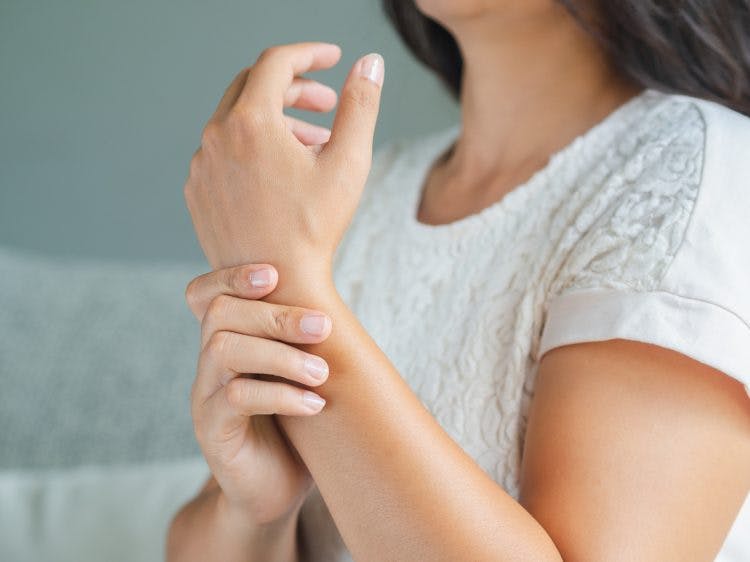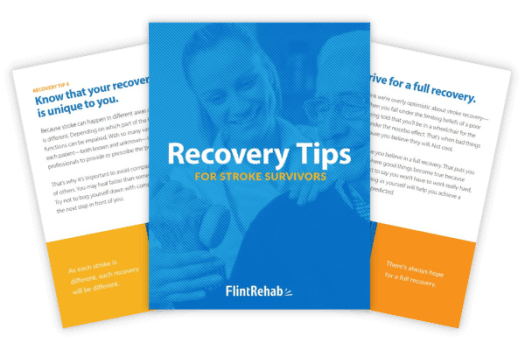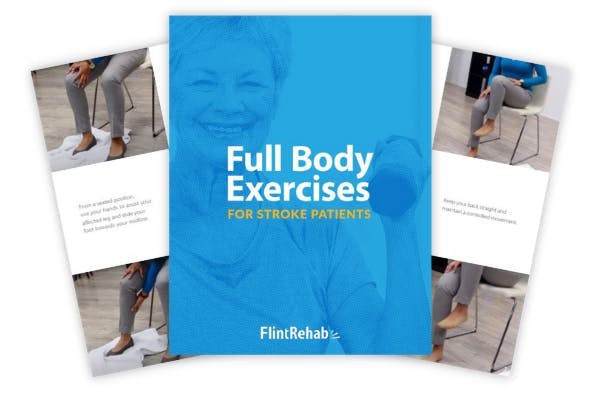No products in the cart.
No products in the cart.
No products in the cart.
No products in the cart.
Home » Neurological Recovery Blog » Stroke » Swollen Arm After Stroke: How to Manage This Common Complication
Last updated on May 31, 2024

A swollen arm after stroke can lead to discomfort, pain, and difficulty with completing daily activities. Although arm and hand swelling may affect many stroke survivors, those with hemiplegia (one-sided paralysis) or hemiparesis (one-sided weakness) are particularly vulnerable. Lack of movement in the affected limb is often the primary cause of swelling, although other causes are plausible.
It’s important for stroke survivors to talk with their medical team if they experience any swelling after stroke. Primary care doctors can often help determine the cause of swelling and provide appropriate treatment recommendations.
This article will explain why arm and hand swelling may occur after stroke, and describe multiple treatment options. Use the links below to jump directly to any section of this article.
Following a stroke, many survivors experience excessive fluid buildup in the arm and/or hand, resulting in swelling. This fluid, known as lymphatic fluid or lymph, normally flows throughout the body, carrying infection-fighting white blood cells.
The lymphatic system is a part of the immune system designed to filter out toxins and manage the levels of fluid in the body. When fluid leaks out from tiny blood vessels, the lymphatic system picks up this fluid, filters it, and then returns it to the blood vessels through one of two lymphatic ducts in the upper chest.
When the lymphatic system is working properly, muscle and joint movement help to move lymph throughout the body. When muscles contract, it increases the strength of pumping in lymphatic vessels, allowing the fluid to move faster.
Lymph moves through lymphatic vessels and eventually reaches the lymph nodes, where it is filtered. Most lymph nodes are located near the joints. Moving the joints helps to activate the lymph nodes, allowing them to continue filtering and pumping lymphatic fluid throughout the body. However, when muscle and joint movement is limited, the flow of lymph may become impaired, leading to fluid buildup in the affected tissues.
Fluid buildup in the arms or legs is referred to as peripheral edema. While there are many causes of peripheral edema, hemiparesis (one-sided weakness) is the most common cause among stroke survivors.
Because individuals with hemiparesis often do not move their affected arm regularly, the lymphatic system cannot rely on muscle and joint movement to help pump lymphatic fluid out of the arm effectively. This can cause fluid to pool in the arm and hand, which is outwardly apparent as swelling.
Other potential causes of edema after stroke include:
In the hospital after stroke, the medical team can identify and treat edema. If a swollen arm occurs after discharge from the hospital, it’s important to proactively seek medical attention. Since there are numerous ways to manage arm and hand swelling after stroke, it is essential to consult with one’s doctor, physical therapist, and/or occupational therapist to determine which treatments may be most effective.
Movement is often the first line of defense against edema after stroke. Since joint and muscle movement promotes lymphatic flow, moving the affected arm can help pump out excess fluid and reduce swelling.
Although active movement is ideal for promoting lymphatic flow, passive movement can also help to reduce swelling. Active movement occurs when the muscles are voluntarily activated, meaning that the survivor is moving without any assistance.
On the other hand, passive movement occurs when the body is moved by an external force, such as when a therapist moves a survivor’s arm through a specific motion. While not as beneficial as active motion, passive movement can be an excellent tool to address swelling when mobility is limited by conditions such as post-stroke paralysis.
While practicing arm exercises is a great way to encourage arm movement, simply using the affected arm during everyday activities can also help reduce swelling. Using the affected arm when performing activities of daily living can also prevent learned nonuse, or the gradual deterioration of function in an affected extremity.
In addition to promoting the flow of lymphatic fluids, consistent use of the affected arm and hand through therapeutic exercises and activities can help rewire the brain through neuroplasticity. Therefore, arm movement is an excellent way to relieve swelling as well as encourage recovery. A physical or occupational therapist can be a great resource for learning which active or passive exercises may be most effective for promoting recovery and reducing edema.
While intentionally moving the affected arm will often help improve swelling, there are a few other techniques that may also be recommended:
Gravity can have a significant impact on swelling. When the arm is resting at the side with the fingers pointing downward, gravity pulls the lymphatic fluid down. This can potentially cause more fluid to pool in the hand and fingers, since the lymphatic system has to work against gravity to pump fluid up the entire arm.
A simple way to avoid this is to elevate the arm, bringing it above the heart if possible. Elevation encourages the lymphatic fluid to flow more efficiently, and allows gravity to assist with reducing swelling rather than to exacerbate it.
Using fitted compression garments can also be an effective way to address a swollen arm after stroke. Tight-fitting compression gloves and sleeves can help push fluid back into circulation. Survivors interested in trying compression garments should talk with their therapist to ensure that they purchase an appropriate type of garment that is properly fitted.
Massage can help stimulate fluid circulation, which may help reduce swelling in the arm. To encourage the flow of fluid, it is essential to move from the fingers upward toward the armpit when massaging. Massaging in this direction encourages fluid to move up and out of the arm, rather than to be pushed back down into the arm and hand.
There are multiple massage techniques designed to reduce edema. Some techniques use firm pressure, while other focus on enhancing lymphatic flow through gentle, light strokes. Before starting massage, survivors should talk with their doctor or therapist to discover which massage techniques would be most effective.
Therapeutic taping techniques can also help to redirect the flow of fluid out of the arm and hand. Kinesiology tape is a thin, stretchable tape designed to be placed directly on the skin. Specific taping techniques can help encourage lymphatic flow by providing a gentle stretch to the skin and underlying tissues. Survivors interested in trying Kinesio taping to reduce arm and hand swelling should talk with their physical or occupational therapist to learn more.
Techniques such as electrical stimulation, acupuncture, deep breathing, and laser therapy may also be recommended to reduce arm swelling after stroke. However, there is an overall lack of research regarding the best methods for alleviating arm swelling after stroke. Therefore, it is highly recommended to consult with one’s doctor and/or therapists before pursuing treatment.
While elevation, compression, massage and/or Kinesio taping may be effective in reducing swelling temporarily, these treatments are designed to address the symptom of swelling rather than treating the underlying cause. When edema is caused by a lack of lymphatic flow due to limited mobility, using therapeutic movement in combination with the other techniques mentioned above is often most effective.
It is important for individuals who notice new areas of swelling after stroke to make an appointment to talk with a medical professional. Although swelling is generally easy to treat and not worrisome, it can also be caused by serious conditions, such as a blood clot.
Some stroke survivors experience chronic or severe swelling. This may be indicative of a more serious problem, such as lymphedema. In this case, it is recommended that individuals work with a certified lymphedema therapist, a professional trained in specialized techniques to address swelling.
Many stroke survivors may experience a swollen arm after stroke. Oftentimes, this is a result of excess fluid pooling in the affected arm due to limited mobility.
Typically, a combination of treatments is the most effective way to manage swelling. Ask your therapist for recommendations regarding positioning, compression garments, massage, and exercise programs.
Most physical and occupational therapists have a general knowledge of how to treat post-stroke swelling. However, for individuals with extremely persistent or severe swelling, it is recommended to ask a doctor or therapist if there is a local certified lymphedema therapist who can provide more specialized care.

Get our free stroke recovery ebook by signing up below! It contains 15 tips every stroke survivor and caregiver must know. You’ll also receive our weekly Monday newsletter that contains 5 articles on stroke recovery. We will never sell your email address, and we never spam. That we promise.


Do you have these 25 pages of rehab exercises?
Get a free copy of our ebook Full Body Exercises for Stroke Patients. Click here to get instant access.
“My name is Monica Davis but the person who is using the FitMi is my husband, Jerry. I first came across FitMi on Facebook. I pondered it for nearly a year. In that time, he had PT, OT and Speech therapy, as well as vision therapy.
I got a little more serious about ordering the FitMi when that all ended 7 months after his stroke. I wish I hadn’t waited to order it. He enjoys it and it is quite a workout!
He loves it when he levels up and gets WOO HOOs! It is a wonderful product! His stroke has affected his left side. Quick medical attention, therapy and FitMi have helped him tremendously!”
FitMi is like your own personal therapist encouraging you to accomplish the high repetition of exercise needed to improve.
When you beat your high score or unlock a new exercise, FitMi provides a little “woo hoo!” as auditory feedback. It’s oddly satisfying and helps motivate you to keep up the great work.
In Jerry’s photo below, you can see him with the FitMi pucks below his feet for one of the leg exercises:
Many therapists recommend using FitMi at home between outpatient therapy visits and they are amazed by how much faster patients improve when using it.
It’s no surprise why over 14,000 OTs voted for FitMi as “Best of Show” at the annual AOTA conference; and why the #1 rehabilitation hospital in America, Shirley Ryan Ability Lab, uses FitMi with their patients.
This award-winning home therapy device is the perfect way to continue recovery from home. Read more stories and reviews by clicking the button below:
Grab a free rehab exercise ebook!
Sign up to receive a free PDF ebook with recovery exercises for stroke, traumatic brain injury, or spinal cord injury below: